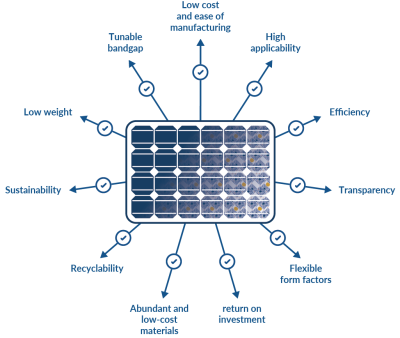Silicon-based solar cells currently dominate the solar market. It is a proven technology, with established manufacturing processes. However, it is also quite expensive to produce, yields rigid cells and has an estimated efficiency limit of around 29%. In recent years, perovskite-based solar technologies have been drawing a lot of attention, and many academics and companies believe they are the future of the solar industry.
Perovskite Solar Cell (PSC) technology is a photovoltaic (PV) technology based on the use of perovskite materials, mostly in the light-absorbing layers of the cell. There are many types of perovskite materials, and several processes used to deposit these materials to create efficient solar panels. PSCs have potential for creating solar panels that are easily deposited onto most surfaces, including flexible and textured ones. They can also be lightweight, cheap to produce, and more efficient than silicon-based solar cells (efficiencies in the lab have already crossed 30%).
The major advantages of perovskite-based solar cells are factors of performance, applicability and sustainability:
- Low cost and ease of manufacturing: Perovskites hold the promise of being a low-cost technology with great ease of manufacture and decreased capital expenditure.
- Tunable bandgap: the bandgap of perovskite solar cells can be modified through control of the composition of the perovskite material.
- High applicability: perovskite materials can absorb wide wavelengths of light, which makes them suitable for unique applications (Agrivoltaics), tandem (to complement Silicon or other PV materials) and to be placed in places where silicon PVs do not function well (indirect lighting, indoor, low sun angles, etc.).
- Efficiency: perovskite-based solar cells are showing an impressive rise in efficiency over in the last decade (recent studies have even passed 30%), and hopefully will allow for high-performance, low-cost PVs.
- Low weight (when produced on plastics, compared to glass-based silicon PVs)
- Flexible form factors: since perovskite materials can be solution-processable, they can be printed or painted over flexible surfaces and enable solar windows, entire rooftops and more.
- Transparency: perovskite materials can enable transparent panels that can be integrated into buildings (BIPV) or other devices.
- Sustainability: soluble production processes are highly efficient in terms of energy and material waste
- Recyclability: most perovskite panels are highly recyclable, some reaching a 100% recyclability rate.
- Abundant and low-cost materials: Perovskites rely on stable and abundant resource materials, such as methylammonia, lead, and iodine.
- Very high return on investment (in terms of Watts/$)
To learn more about the emerging perovskite solar panel industry, the latest technology and trends, and what the future holds for perovskites, check out our recently-published Perovskite for the Solar Industry Market Report.
